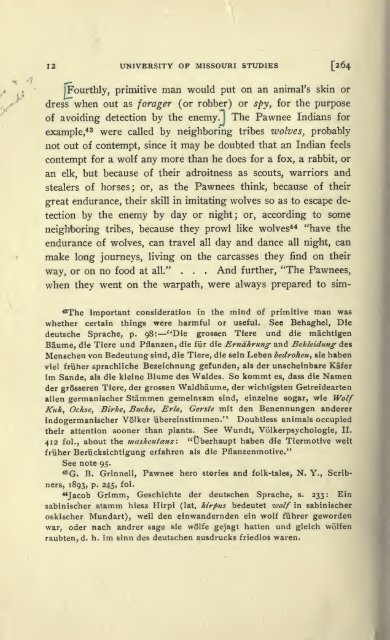origin of were wolf
You also want an ePaper? Increase the reach of your titles
YUMPU automatically turns print PDFs into web optimized ePapers that Google loves.
12 UNIVERSITY OF MISSOURI STUDIES 2 4<br />
J Fourthly, primitive man would put on an animal's skin or<br />
dress when out as forager (or robber) or spy, for the purpose<br />
<strong>of</strong> avoiding detection by the enemy. 1 The Pawnee Indians for<br />
example, 43 <strong>were</strong> called by neighboring tribes wolves, probably<br />
not out <strong>of</strong> contempt, since it may be doubted that an Indian feels<br />
contempt for a <strong>wolf</strong> any more than he does for a fox, a rabbit, or<br />
an elk, but because <strong>of</strong> their adroitness as scouts, warriors and<br />
stealers <strong>of</strong> horses; or, as the Pawnees think, because <strong>of</strong> their<br />
great endurance, their skill in imitating wolves so as to escape detection<br />
by the enemy by day or night; or, according<br />
to some<br />
neighboring tribes, because they prowl like wolves44 "have the<br />
endurance <strong>of</strong> wolves, can travel all<br />
day and dance all night, can<br />
make long journeys, living on the carcasses they find on their<br />
way, or on no food at all." And . further, "The Pawnees,<br />
. .<br />
when they went on the warpath, <strong>were</strong> always prepared to simimportant<br />
consideration in the mind <strong>of</strong> primitive man was<br />
whether certain things <strong>were</strong> harmful or useful. See Behaghel, Die<br />
deutsche Sprache, p. 98: "Die grossen Tiere und die machtigen<br />
Baume, die Tiere und Pflanzen, die fur die Ernahrung and Bekleidung des<br />
Menschen von Bedeutung sind, die Tiere, die sein Leben bedrohen, sie haben<br />
viel friiher sprachliche Bezeichnung gefunden, als der unscheinbare Kafer<br />
im Sande, als die kleine Blume des Waldes. So kommt es, dass die Namen<br />
der grosseren Tiere, der grossen Waldbaume, der wichtigsten Getreidearten<br />
alien germanischer Stammen gemeinsam sind, einzelne sogar, wie Wolf<br />
Kuh, Ochse, Birke, Buche, Erie, Gerste mit den Benennungen anderer<br />
indogermanischer Volker iibereinstimmen." Doubtless animals occupied<br />
their attention sooner than plants. See Wundt, Volkerpsychologie, II.<br />
412 fol., about the maskentanz'. "Uberhaupt haben die Tiermotive weit<br />
friiher Beriicksichtigung erfahren als die Pflanzenmotive."<br />
See note 95.<br />
43<br />
G. B. Grinnell, Pawnee hero stories and folk-tales, N. Y., Scribners,<br />
1893, p. 245, fol.<br />
"Jacob Grimm, Geschichte der deutschen Sprache, s. 233: Ein<br />
sabinischer stamm hiesz Hirpi (lat. hirpus bedeutet <strong>wolf</strong> in sabinischer<br />
oskischer Mundart), weil den einwandernden ein <strong>wolf</strong> fiihrer geworden<br />
war, oder nach andrer sage sie <strong>wolf</strong>e gejagt hatten und gleich <strong>wolf</strong>en<br />
raubten, d. h. im sinn des deutschen ausdrucks friedlos waren.


